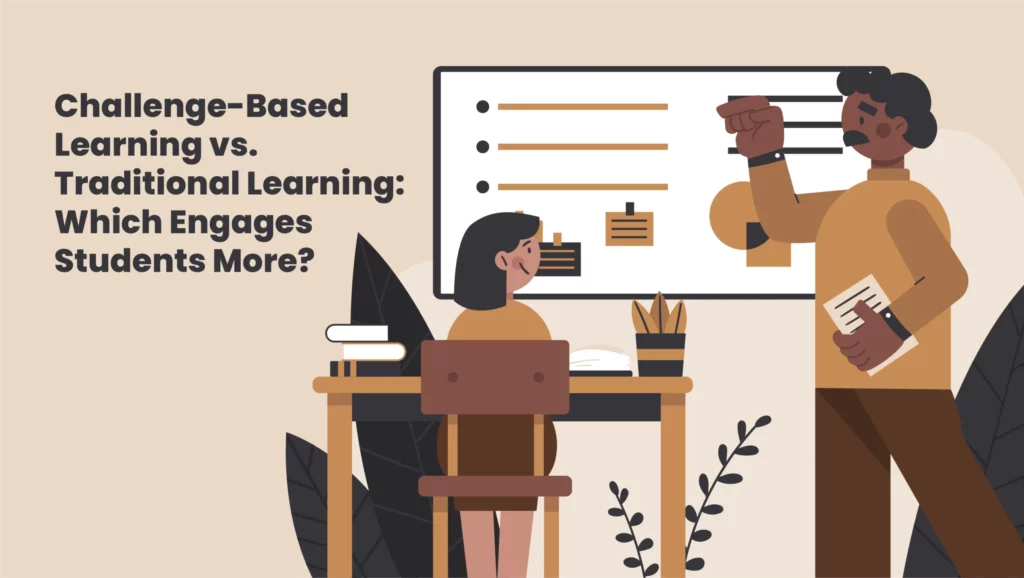A major value point of the challenge-based learning method is the hands-on experience that students enjoy. Apple’s CBL case studies found that challenge-based learning engages students in an exceptional way: over 75% of students surveyed, from primary to post-secondary, reported that they worked harder than they normally do and had learned more than was required of them.
The increased interaction that students experience, with the content itself, their peers, and themselves, makes all the difference from traditional learning forms.
What do these three types of interaction look like?
INTERACTION WITH CONTENT
Studies have shown that students retain knowledge longer with challenge-based learning because of their increased engagement with their learning content. The hands-on nature of the challenges gives students more incentive to learn. Challenge-based learning allows students the exciting opportunity to truly apply themselves, their skills, and their creativity with problem-solving innovation. We Forum’s 2019 Schools of the Future report discusses the impact of interaction with one’s education, highlighting the difference between “traditional forms of topdown direct teaching” in which “students are passive recipients” and “interactive methods” like challenge-based learning, which fosters innovation and creativity because of its interactive dimension. This approach shifts the teacher’s role from a lecturer to a coach, stepping back to allow students to take initiative for their education.
The post-secondary students of Miami University found their interaction with the content to be extra meaningful because they felt a real sense of accomplishment in completing a project. This feeling motivates them to work harder. Moreover, the real-world relevance of the challenges encourages student engagement as students not only feel accomplished by having finished a project but also by making a difference, offering an innovative solution to a real problem. The enthusiasm to solve challenges is increased because of the tangible relevance that the challenges have.
INTERACTION WITH PEERS
With the hands-on method of challenge-based learning, students interact with their peers, too. Challenge-based learning, which emphasizes modern tools, empowers students with modern-day collaboration. Researcher Charles Fadel found that collaboration is one of the primary 21st-century skills, along with soft skills like communication, which is nurtured by collaborative experiences. Not only are these in-demand future-proof skills important for students’ future career paths, but they are also essential elements of the challenge-based learning framework: students connect with each other in collaboration, each bringing their unique strengths to the project, and learn from each other.
Moreover, the interaction with peers that students enjoy with challenge-based learning provides them with an enriching opportunity to gain emotional intelligence. A study done with first-year university students found that students gained emotional intelligence from challenge-based learning, which is to say that they gained a stronger intrapersonal understanding of themselves, interpersonal understanding of others, adaptability in new environments, and stress management.
The peer interaction that students experience in challenge-based learning grants the significant benefit of in-demand soft skills like communication and emotional intelligence, which are undoubtedly valuable for the future of work.
INTERACTION WITH THE SELF
In challenge-based learning, the learner interacts with the self in meaningful ways. This is to say that students gain a clearer understanding of their personal and professional identity when participating in a hands-on, challenging activity.
Interactive or work-integrated learning methods like challenge-based learning allow students to explore their strengths and weaknesses, passions, creativity, work habits, and motivations. Students reflect on their interactive learning more than they do with passive forms of learning. As such, their development can make a more considerable impact on their self-confidence and motivation to work harder. This kind of self-exploration is crucial for students’ successful transition into the workforce after education. Students build a stronger sense of self from learning that allows them to interact with problem solving that is relevant, applicable in real life, and meaningful to them.
Apple’s challenge-based learning studies in a primary school highlighted that students had the opportunity to try on new roles, like the role of a creative contributor or leader, which they may not have the ability to do in a traditional classroom setting. In the same studies conducted with middle school students, researchers found this to be true, too, with unconventionally intelligent students (“not your straight-A kind of kids”) shining in a hands-on environment, presenting their exceptional creativity and teamwork skills. Likewise, for post-secondary students, those who were unfamiliar with leadership roles found themselves becoming comfortable leading a creative project and taking ownership of their ideas and contributions.
Challenge-based learning engages students in unique ways with enriching interactions with content, peers, and the self. Compared to more passive traditional learning, challenge-based learning engages students more and grants them real-world skills from hands-on activity.

